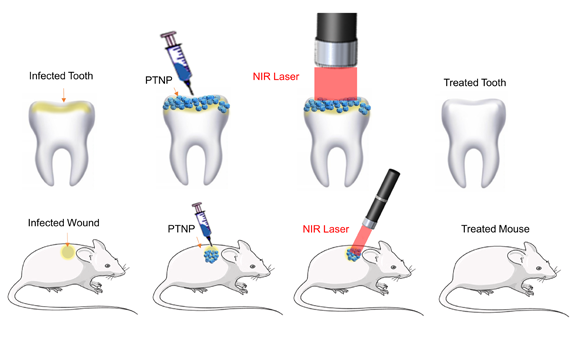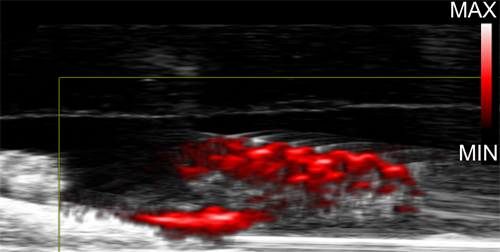Dual-purpose nanoparticles help image and zap entrenched bacteria in animal study
If left to their own devices, bacteria on our teeth or wounded skin can encase themselves in a slimy scaffolding, turning into what is called biofilm. These bacteria wreak havoc on our tissue and, being shielded from antibiotic medication by the slime, are difficult to dislodge. A new strategy may offer a simple way to break up the muck and destroy the bacteria.
Researchers at the University of Pennsylvania and Stanford University have developed sugar-coated gold nanoparticles that they used to both image and destroy biofilms. In a study published in the Journal of Clinical Investigation, the authors demonstrated the diagnostic and therapeutic potential of the nanoparticles on the teeth and wounded skin of rats and mice, eliminating the biofilms in as little as one minute and outperforming common antimicrobials.
“With this platform, you can bust biofilms without surgically debriding infections, which can be necessary when using antibiotics. Plus, this method could treat patients if they are allergic to antibiotics or are infected by strains that are resistant to medication,” said Luisa Russell, Ph.D., a program director in the Division of Discovery Science & Technology at NIBIB. “The fact that this method is antibiotic-free is a huge strength.”

Oral biofilms, also known as plaques, formed by bacteria such as Streptococcus mutans can cause significant tooth decay. Wound infections, which are commonly caused by Staphylococcus bacteria, can greatly delay the healing process. In either case, the densely packed network of proteins and carbohydrates within biofilms can prevent antibiotics from reaching microbes throughout the affected area.
But that isn’t the extent of the issue posed by biofilms. Not only are they difficult to remove, but they are troublesome to discern in the first place.
This new research identified a solution to knock out both problems with one stone: gold.
Gold is nontoxic and readily converts energy from light sources into heat, making it a prime candidate for photothermal therapy, a strategy that utilizes the heat from nanoparticles to kill nearby pathogens. In addition to generating heat, the nanoparticles emit detectable ultrasound waves in response to light, meaning that gold particles can be visualized using a technique called photoacoustic imaging.
In the new study, the authors encapsulated gold spheres within larger golden cage-shaped nanoparticles to optimize their response to light for both therapeutic and imaging purposes. To make the particles appealing to bacteria, they coated them in dextran, a carbohydrate that is a common building block of biofilms.
The researchers assessed their strategy by applying the gold nanoparticles atop S. mutans-infected teeth from ex vivo rat jaws.

In a photoacoustic imaging test on the teeth, the nanoparticles emitted signals that came through loud and clear, allowing the team to see precisely where biofilms had taken up the dextran-coated particles on the teeth.
Then, to evaluate the particles’ therapeutic effect, they irradiated the teeth with a laser. For comparison, they treated other infected teeth samples with the topical antiseptic chlorhexidine.
The team observed a stark contrast in the outcomes of the two treatments, with the photothermal therapy being nearly 100% effective at killing biofilms, while chlorhexidine did not significantly diminish the viability of bacteria.
“The treatment method is especially fast for the oral infection. We applied the laser for one minute, but really in about 30 seconds we’re killing basically all of the bacteria,” said study first author Maryam Hajfathalian, Ph.D., a professor of biomedical engineering at the New Jersey Institute of Technology, who conducted this study while a postdoctoral researcher at both the University of Pennsylvania and Stanford University.
Evaluations conducted on mice with open wounds in their skin, infected with Staphylococcus aureus, were similarly successful, as heat generated by nanoparticles greatly outperformed another antimicrobial agent called gentamicin. Here, the researchers also measured and noted a rise in temperature of 20°C localized to the biofilm, not causing any apparent damage to surrounding tissue.
The authors indicate that with further tests they aim to show whether the strategy can prevent cavities or speed up healing.
“I think it's important to see how inexpensive, straightforward, and fast this process is. Since we are limited in using antibiotics, we need novel treatments like this as a replacement,” Hajfathalian said.
This research was supported by grants from NIH, including NIBIB (K99EB028838), the National Institute of Dental and Craniofacial Research (R01DE025848), the National Heart, Lung, and Blood Institute (R01HL131557), and the National Institute of Allergy and Infectious Diseases (T32AI007502).
This science highlight describes a basic research finding. Basic research increases our understanding of human behavior and biology, which is foundational to advancing new and better ways to prevent, diagnose, and treat disease. Science is an unpredictable and incremental process—each research advance builds on past discoveries, often in unexpected ways. Most clinical advances would not be possible without the knowledge of fundamental basic research.
Study reference: Maryam Hajfathalian et al. Theranostic gold-in-gold cage nanoparticles enable photothermal ablation and photoacoustic imaging in biofilm-associated infection models. Journal of Clinical Investigation. DOI: 10.1172/JCI168485
About the graphics: The graphics are adapted from figures licensed under the terms of the Creative Commons Attribution 4.0 International License.
